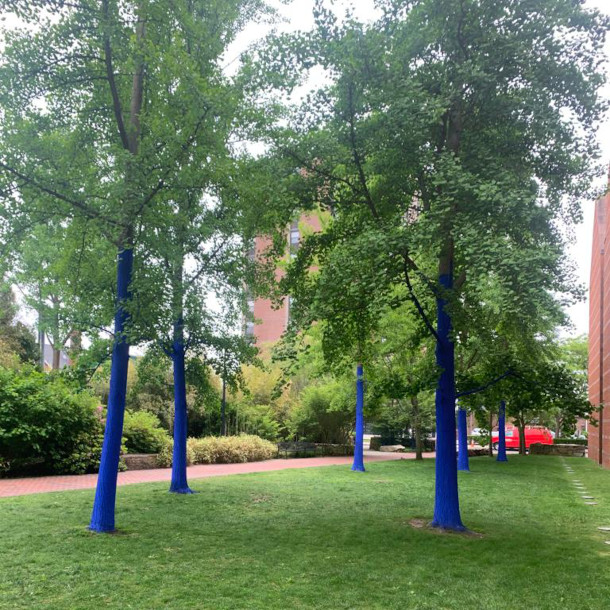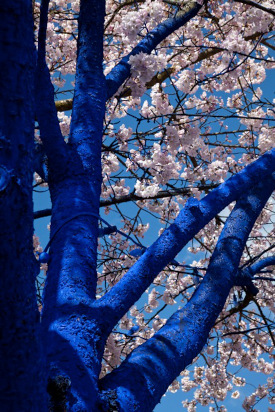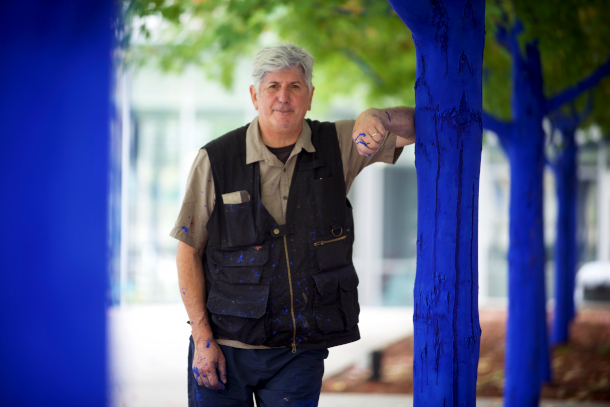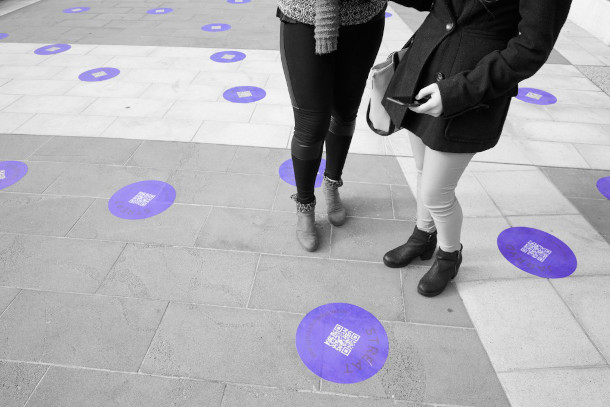Blue Trees Against Deforestation
Air Date: Week of July 22, 2022

Blue trees outside the Peabody Essex Museum in Salem, Massachusetts. (Photo: Jacob Rego)
Artist Konstantin Dimopoulos talks with host Bobby Bascomb about his project to paint tree trunks bright blue to raise public awareness about deforestation.
Transcript
BASCOMB: Conversations about climate change often focus on the destruction and degradation of the natural world, but artists like Konstantin Dimopoulos are taking a different approach, raising awareness with art. The Blue Trees project is one of his recent pieces of artwork. As the name suggests, he paints tree trunks bright blue, creating a brilliant contrast with the greens, yellows, and oranges of the leaves and natural scenes that surround it. He and his team have worked on installations all over the world, several of which are based in the U.S, including one now in Salem, Massachusetts. For more I’m joined by the artist himself. Konstantin Dimopoulos, welcome to Living on Earth!
DIMOPOULOS: Thank you very much for having me.
BASCOMB: Tell us first please about this art installation. Where have you painted the trees blue and any idea how many you have so far?
DIMOPOULOS: Well, we started in 2003 in Melbourne, Australia. Where I grew up in New Zealand, Wellington, there were very few trees. When we came to Melbourne, it was just amazing. It's one of the largest urban forests in the world. And so that started me looking at trees. And then I went to visit Friends of the Earth. And while I was there, someone had come back from Southeast Asia, and showed us images of this incredible ecocide. And they said, how can we get people in cities to be aware that this is happening, and so I came up with an idea of coloring trees blue. And it's not just coloring trees, we work with children in schools. A lot of trees are donated back into this community, and we've done it in about 30 cities around the world, maybe over 100 sites, and it continues to grow.
BASCOMB: And why make the trees blue? What does that represent to you?

With the exception of the Colorado blue spruce blue trees that naturally typically don’t grow in nature, Konstantin explains. Hence, he chose an electric blue to capture the attention of passersby. (Photo: Konstantin Dimopoulos, Wikimedia Commons, CC BY 3.0)
DIMOPOULOS: How do you get people to stop and slow down, it's the color that will grab attention. You're fighting for attention in the world today. Blue doesn't exist in trees. Now there are red trees, there are a yellow trees, there are green trees. And one of the things I always remember was, in the 1970s, a group of Greenpeace activists went to the Arctic and actually colored seal pups blue, because they'd been being killed for their fur. Part of that was maybe if we put something on a tree, it make people to say what's happening. You know, nature uses color in a variety of ways. It's an incredible powerful attraction, usually it's the male that's all colorful, to get an attraction from someone. Or, like here in Australia, you have a red back spider, and it has a color on it to say, don't come near me, I am dangerous. So, color has always been an important part of the ecosystem.
BASCOMB: And to be clear, the color that you use is nontoxic and it washes off, it's not hurting the trees.
DIMOPOULOS: No, we've had it tested by science. You know, in Greece, when I was young, my father colored olive trees white to protect them from bugs. In Colorado, there were over 100,000 trees a day dead because of the pine beetle. In the Northern Hemisphere, like Norway and Sweden, they also color them white to protect them from the cold. So, it's not a new technique, it's just that the mixture that I've done is very, very intense, electric blue. And this washes off. Virtually all the places that we've created it now has disappeared. It's just no longer.
BASCOMB: So, you've mentioned that you work a lot with schools and children to do this art installation. I understand that you've also worked with people in the homeless community. Can you tell me more about that?

Konstantin Dimopoulos is an environmental and social artist. (Photo: Courtesy of Konstantin Dimopoulos)
DIMOPOULOS: I guess I see myself as a social artist, homeless was affected when we're doing the blue trees in Seattle. And they said whatever you do, just be aware there's a lot of homeless there, don't interact with them. When we got there, they were just lovely. You know, one lovely girl, Clara—she was an artist, and she had artworks there. And my wife Adele would say, Clara, do you mind going to get some coffee for the team. And she'd go and give her the money. She'd never returned any money. But we didn't mind because she was working, you know. And other people said, I'm going to sleep underneath the tree tonight, so nobody hurts it. They were just lovely people. One was a Microsoft executive that lost his job, you know, he came with a suit and everything. And you know, these are people with families that need help. And so, I did work called Purple Rain, using QR codes, we talked to about 12 to 15 homeless who have turned things around. But we talked about their success, how tough it is, you know, some of the domestic violence and stuff that they've gone through is horrific. Although I'd like to think that we as artists are the light of the world, I think we're really the cracks of the world. You know, I love that Leonard Cohen song, when it's a ring, the bells that still can ring forget your perfect offering. There is a crack in everything. That's how the light gets in. So, we're not actually the light of the world. But we are the cracks that allows the light to come through.
BASCOMB: What kind of reactions have you had to the blue trees so far?
DIMOPOULOS: In most cases, people are positive. But some people are fighting why you're doing this to our trees. You know, people don't like their environment changed, but we go into other species’ environments and change them massively. And when you remove a tree, you don't just remove a tree. You can't bring back the species that exists within them. And it is good that people get stirred up about what we're doing to the trees, but they need to also look at it globally. Because whatever happens in the Amazon will affect what happens in Boston. And so, when people look at the blue trees and say well, that's insane. I say well, you know a tree would rather be blue than be cut down if that was the choice of the tree.

Purple rain is one of Dimopoulos’s recent projects where one can scan a QR code and get background information about homeless people’s lives. (Photo: Courtesy of Konstantin Dimopoulos)
BASCOMB: How do you think this art installation might inspire change? I mean, what is your hope for this installation? What's your goal here?
DIMOPOULOS: Initially, there was no idea of what was going to happen. But I think what's happening is as we go to different cities, it's almost as though people are drawing a line and saying, our city is going to become more environmentally conscious. It's really, it's important just to get it out, because it's almost as though nobody was caring in some ways. And what the blue tree tries to do is actually just raise the idea.
BASCOMB: What do you see as the role of beauty in this fight against climate change, which can so often seem just ugly and destructive?
DIMOPOULOS: Art for me, there is a beauty about it. Someone looked at the blue trees that we did in Houston and was telling him about the issues about deforestation said yes, but they also looked incredible. And that's the thing is, you're looking at the trees in a different way. And I think art throughout the world has been a way of bringing us closer to beauty. I think that the importance of art is how really beautiful the world is and how we forget about that in some ways.
BASCOMB: Konstantin Dimopoulos is an artist and creator of The Blue Trees installation. Konstantin, thank you so much for your time today.
DIMOPOULOS: No, thank you so much, and good luck with everything.
Links
Living on Earth wants to hear from you!
Living on Earth
62 Calef Highway, Suite 212
Lee, NH 03861
Telephone: 617-287-4121
E-mail: comments@loe.org
Newsletter [Click here]
Donate to Living on Earth!
Living on Earth is an independent media program and relies entirely on contributions from listeners and institutions supporting public service. Please donate now to preserve an independent environmental voice.
NewsletterLiving on Earth offers a weekly delivery of the show's rundown to your mailbox. Sign up for our newsletter today!
 Sailors For The Sea: Be the change you want to sea.
Sailors For The Sea: Be the change you want to sea.
 Creating positive outcomes for future generations.
Creating positive outcomes for future generations.
 Innovating to make the world a better, more sustainable place to live. Listen to the race to 9 billion
Innovating to make the world a better, more sustainable place to live. Listen to the race to 9 billion
 The Grantham Foundation for the Protection of the Environment: Committed to protecting and improving the health of the global environment.
The Grantham Foundation for the Protection of the Environment: Committed to protecting and improving the health of the global environment.
 Contribute to Living on Earth and receive, as our gift to you, an archival print of one of Mark Seth Lender's extraordinary wildlife photographs. Follow the link to see Mark's current collection of photographs.
Contribute to Living on Earth and receive, as our gift to you, an archival print of one of Mark Seth Lender's extraordinary wildlife photographs. Follow the link to see Mark's current collection of photographs.
 Buy a signed copy of Mark Seth Lender's book Smeagull the Seagull & support Living on Earth
Buy a signed copy of Mark Seth Lender's book Smeagull the Seagull & support Living on Earth

